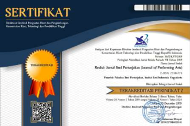Rancangan Garap Karya Gending Sekar Jagad Berbasis Motif Batik Gaya Yogyakarta
Abstract
The creation of works employing transforming media becomes an exciting breakthrough in the art industry to study. Using the concept of changing the media, the meeting of the two different media, such as art and music, provides opportunities for the emergence of a broader range of creative work. The design of musical works based on the inspiration and philosophy from the media of batik has complexity and beauty and high value as the great works from the Indonesian ancestors. Sekar Jagad is a title for the composition of musical design, taken from the name of a batik motif that is very familiar in Javanese culture. By understanding the basic batik motifs such as gringsing, kawung, machete, nitik, cement and poleng, the elements of vocal melodies performed in two different voices gave an overview of the concept of the Sekar Jagad batik motif. It indeed required knowledge of the shape, function and character of the batik motif itself as the basis for gending in musical arts. The melody arrangement was made entirely with two tunings or pelog and slendro scales. It was intended to find the characters that best suits the characteristics and philosophy of batik. The elements of batik motifs that were put together into one Sekar Jagad batik motif were then applied through vocal melodies and supported by lyrics that described some of these batik elements.
Keywords
Full Text:
PDFReferences
batik.or.id. (2014). Makna dan Filosofi Batik Sekar Jagad. Retrieved June 5, 2020, from https://batik.or.id/makna-dan-filosofi-batik-sekar-jagad/
Bluestone, G. (1957). Novels into Film. Berkeley and Los Angeles: University of California Press.
Cooper, N. I. (2015). Retuning Javanese Identities: The Ironies of a Popular Genre. Asian Music, 46(2), 55-88,145. Retrieved from https://search.proquest.com/docview/1691586168?accountid=38628
Eneste, P. (1991). Novel dan Film. Flores: Penerbit Nusa Indah.
Hardjana, S. (2004). Musik antara Kritik dan Apresiasi. Jakarta: Penerbit Buku Kompas.
Isaacs, N. D. (1970). Fiction into Film: A Walk in The Spring Rain. New York: A Delta Book.
Iser, W. (1987). The Act of Reading: A Theory of Aesthetic Response. London: The Johns Hopkins Press Ltd.
Junaidi, A. A. (2013). Janengan Sebagai Seni Tradisional Islam-Jawa. Walisongo: Jurnal Penelitian Sosial Keagamaan, 21(2), 469. https://doi.org/10.21580/ws.2013.21.2.254
Kristeva, J. (1987). Desire in Language: A Semiotics Approach to Literature and Art. England: Basil Blackwell Ltd.
Napiah, A. R. (1994). Tuah-Jebat dalam Drama Melayu: Suatu Kajian Intertekstualiti. Kuala Lumpur: Dewan Bahasa dan Pustaka Kementerian Pendidikan Malaysia.
Prasetya, H. B., Haryono, T., & Simatupang, L. L. (2011). Habitus,Ngêng, dan Estetika Bunyi Mlèsèt dan Nggandul pada Karawitan. Paradigma: Jurnal Kajian Budaya, 1(2), 152–167.
Prasetya, H. B., & Susanto, A. (2016). Mleset Dalam Karawitan: Kasus Pada Gending Pangkur. Gelar: Jurnal Seni Dan Budaya, 8(2), 168–178. https://doi.org/10.33153/glr.v8i2.1327
Purwanto, J. (2010). Ricikan Kethuk Pada Karawitan Jawa Gaya Surakarta. Gelar: Jurnal Seni Dan Budaya, 8(2), 207–218.
Qoimah, H. (2012). Karakteristik Batik Motif SekarJagad Yogyakarta. Yogyakarta.
Ratna, N. K. (2005). Sastra dan Cultural Studies: Representasi Fiksi dan Fakta. Yogyakarta: Pustaka Pelajar.
Saearani, M. F. T. bin, Simatupang, G. L. L., Soedarsono, R. M., & Kusmayati, A. M. H. (2014). Cultural Transformation Processes in the Current Development of Yogyakarta-Style Classical Dance. International Journal for Innovation Education and Research, 2(04), 134–141. Retrieved from http://www.ijier.net/assets/cultural-transformation-processes-in-the-current-development-ijier.net-vol-2-4_12.pdf
Sahlan, A., & Mulyono. (2012). Pengaruh Islam Terhadap Perkembangan Budaya Jawa: Tembang Macapat. El Harakah: Jurnal Budaya Islam, 14(1), 101–114.
Salma, I. R., Masiswo, Satria, Y., & Wibowo, A. A. (2015). Pengembangan motif batik khas bali. Dinamika Kerajinan Dan Batik:Majalah Ilmiah, 32(1), 23–30.
Subuh. (2016). Garap Gending Sekaten Keraton Yogyakarta. Resital: Jurnal Seni Pertunjukan, 17(3), 178–188.
Sumarsam. (1995). Gamelan: Cultural Interaction and Musical Development in Central Java. Chicago: The University of Chicago Press.
Supriatna, E. (2010). Fungsi Seni Gembyung dalam Kehidupan Masyarakat Panjalu Kabupaten Ciamis. Patanjala, 2(3), 394–410.
Surya, M. C., & Tresna P., P. (2012). SEKAR JAGAD IN VICTORIAN STYLE. Fesyen Perspektif, Vol 1, No(No 1). Retrieved from ejournal.upi.edu
Suyatno, S., Tjokronegoro, H. A., Merthayasa, I. G. N., & Supanggah, R. (2016). Analysis of Onstage Acoustics Preference of Musicians of Traditional Performance of Javanese Gamelan Based on Normalized Autocorrelation Function. Journal of Engineering and Technological Sciences, 48(5), 571–583. https://doi.org/10.5614/j.eng.technol.sci.2016.48.5.5
Syarif, A. M., & Hastuti, K. (2015). Identifikasi Fitur Melodi Gending Lancaran Berdasarkan Pengenalan Pola Notasi. Techno.COM, 14(3), 234–241.
Teguh. (2017). Ladrang Sobrang Laras Slendro Patet Nem. Resital, 18(2), 103–112.
Widodo. (2015). Laras in Gamelan Music’s Plurality. Harmonia: Journal of Arts Research and Education, 15(1), 34–45. https://doi.org/10.15294/harmonia.v15i1.3695
DOI: https://doi.org/10.24821/resital.v21i3.4110
Refbacks
- There are currently no refbacks.
This work is licensed under a Creative Commons Attribution 4.0 International License.



